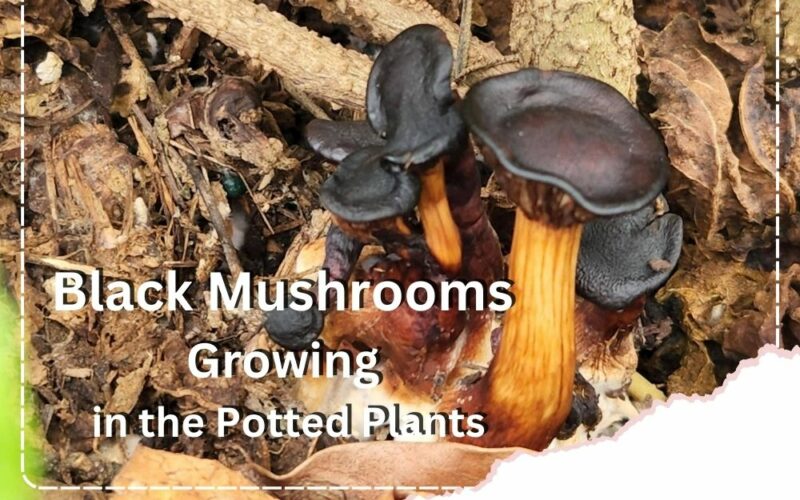Join this post to raise our knowledge about another challenge of indoor gardening. Have you spotted black mushrooms growing in the potted plants? don’t worry, keep reading to find out the answer to all the questions you are searching for about black mushrooms from identification to getting rid of them.
I discussed various types of mushrooms that grow in houseplants in my previous posts, including:
- Brown mushrooms growing in potted plants
- White mushrooms growing in potted plants
- Grey mushrooms in potted plants
- Yellow mushrooms growing in houseplants
Here, I want to tell you about the black mushrooms growing in the potted plants. First, you will find 5 common types of black mushrooms that you may spot in your houseplant soil, and then I will help you to get rid of them.
If you are interested to know:
➡ Are black mushrooms growing in my houseplants poisonous?
➡ Is it bad if black mushrooms are growing in my potted plants?
➡ Are mushrooms in my houseplant good luck?
➡ How to get rid of black mushrooms growing in my houseplants?
Keep reading to find the best answers. I’m a plant pathologist who works as a horticultural advisor, please feel free to ask your questions below this page. I will answer them as soon as possible. Now, let’s start.
➡ You can also hear the audio version of this article.
What are Black Mushrooms Growing in the Potted Plants?
Before starting I want you to note that sometimes distinguishing between black mushrooms and dark brown mushrooms is difficult, so, you may not find the black mushroom growing in your houseplant in the below list. Hence, I recommend reading my other article about indoor brown mushrooms growing in houseplants.
In addition, some mushrooms turn dark to black with age, so, for example, you may find white mushrooms that change to black in maturity.
Black-Edged Shield Mushroom

Scientific name: Pluteus atromarginatus
It is also known as a Black-Margined Shield, or Dark-Rimmed Pluteus.
Appearance:
Initially, you find the caps convex but become flattened with age. The caps are grayish-brown, reddish-brown, dark brown with a darker margin. Hence, some people assume they are black mushrooms.
The caps are also between 2-6 cm in diameter with thin and fragile flesh on top of a cylindrical stem. The stem is sometimes curved and can be up to 10 cm long. You will find them paler than the cap with fine white hairs near the base.
Habitat:
Pluteus atromarginatus is a saprophytic mushroom that similar to other mushrooms growing in houseplants, loves to thrive in moist environments and rich soils. It lives on decaying hardwood logs, stumps, and mulch. So, in outdoor conditions, you can find it in woodlands, forest edges, and gardens during the fall season.
Common Inkcap Mushroom

Scientific name: Coprinopsis atramentaria
People also called it Tippler’s Bane or Alcohol Inky.
Appearance:
It is one of the wonderful mushrooms with a bell-shaped pale gray to brown cap that becomes conical and eventually dissolves into a black inky fluid. Hence it is called Inkcap mushroom. This mushroom has rapid growth, so if you spot its maturity form in your houseplant, you may think there is a black mushroom growing in your potted plant.
The caps are typically between 2-8 cm in diameter on top of the cylindrical stems (usually between 5-12 cm long). The stems are bulbous at the base and get hollow as the cap dissolves.
Habitat:
Coprinopsis atramentaria is a saprophytic mushroom that loves nutrient-rich soil. Hence, you often spot them near decaying organic matter such as compost piles, manure, or rotting plant material. It is one of the mushrooms growing in houseplants, however, you can find it in grassy areas, lawns, gardens, and waste areas too.
Shaggy Ink Cap Mushroom

Scientific name: Coprinus comatus
This mushroom is also known as Shaggy Mane or Lawyer’s Wig.
Appearance:
It is a distinct mushroom with an elongated cap that is shaped like a cylinder or cone. In addition, shaggy white scales cover the cap’s surface. Very nice! Initially, the cap is tightly closed and resembles a white egg but eventually, the cap opens up and you can see its gills on the underside and turn grey to black.
The young caps are between 6-20 cm tall and 1-3 cm in diameter and placed on top of the cylindrical, white stems. In maturity, the cap and stem will be covered with a black inky fluid.
Habitat:
Coprinus comatus is another saprophytic mushroom growing in houseplants and can be found in a variety of habitats too. In outdoor environments, you will find it in nitrogen-rich soil such as grassy areas, meadows, lawns, and along roadsides during the late spring to autumn seasons.

Scientific name: Leotia lubrica
Its other common name is Green-headed Jellybaby Mushroom.
Appearance:
You may be shocked why I put this pale yellow to olive green mushroom among the Black mushrooms growing in potted plants, indeed, some varieties turn to dark brown or black and you can see them in your houseplant soil.
The young ones have bell- or cone-shaped caps that turn flattened with age with a slimy or sticky surface. The cap can grow up to 3 cm wide and 1-6 cm tall. The stem can be up to 10 cm long and is often twisted.
Habitat:
Leotia lubrica often thrives in soil rich with a lot of organic matter such as woodland areas (often coniferous forests but can also be found in mixed woodlands). The damp habitats such as mossy areas, decaying wood, and leaf litter are proper for living this mushroom. Hence, it can be a black mushroom growing in potted plants.
Are Black Mushrooms Growing in My Houseplants Poisonous?
Indeed, the black mushrooms that grow in potted plants may vary from edible to poisonous. For example, while the Jelly Baby is a toxic mushroom (despite its name), Coprinus comatus not only is an edible mushroom with a delicious taste but has also medicinal usage.
Some black mushrooms growing in potted plants are edible but must be used with caution. For example, although Coprinopsis atramentaria is an edible mushroom, due to containing Coprine, if you consume it with alcohol will be poisonous.
I couldn’t find valid evidence about the poisonous or edibility of Pluteus atromarginatus. Anyway, I strongly recommend avoiding eating any black mushrooms growing in potted plants. because distinguishing between edible and toxic mushrooms is a critical job that must be done by experts.
Is it Bad if Black Mushrooms are Growing in My Potted Plants?
Despite their toxicity matter for humans and pets, the mushrooms growing in house plants not only are not harmful to potted plants but also have a lot of benefits for them. The mushrooms turn the decayed stuff in the soil into nutrient foods for plants and help you to have a greener house.
In addition, they can add a piece of beauty and naturality to your indoor décor. So, if you are ensuring your little kids or playful pets never eat mushrooms, black mushrooms growing in potted plants are not bad.
Are Mushrooms in my Houseplant Good Luck?

It is another frequent question that people often want to know about. I asked about it a lot and found out that in some cultures such as the UK, people assume growing mushrooms in houseplants is good luck and there are several superstitions about them. If you are interested in knowing more, I recommend my other post “Are growing mushrooms in my house plant good luck?”.
How to Get Rid of Black Mushrooms Growing in Potted Plants?
No matter whether you see a black mushroom in your potted plant or other types of mushrooms in your houseplant, if you think should get rid of them, the remedies will be the same.
➡ When mushrooms produce caps, they soon release thousands of spores in your house’s atmosphere. The spores after landing on your houseplant soil (or any humid environment), will thrive and new mushrooms will appear. Hence, one of the things that you must do is cut the mushrooms immediately.
➡ However, what you assume a mushroom is only the fruit part of a fungus that lives inside the soil. When you cut the caps (fruit parts), the main fungus will produce other caps quickly. So, you must remove caps with several inches of the topsoil.
➡ The best way is to repot the potted plant, wash its roots and planter, and finally pot it with sterile soil. however, your plant may be shocked. In addition, if there are mushrooms in other houseplants or your yards near the open window, the spores will infest its soil again.
You can change the mushrooms’ favourite conditions too. For example, let several inches of topsoil dry out or avoid using rich soils with a lot of decayed materials. I recommend reading my other post “How to get rid of mushrooms in houseplants” to find more remedies in detail.
Conclusion
In this post, I tried to help you identify the black mushrooms growing in potted plants. I showed you 4 of them with their images and even more, however, you may spot other black mushroom species that I didn’t mention here. you can raise this post by telling us about your observation of black mushrooms growing in your houseplants and your experiences below this page.

Elahe Rabiei
Hi, I’m Elaheh. My Academic major is plant protection, and houseplants are my expertise. As a houseplant lover, my house is full of indoor plants and it is my passion to take care of them. Hence, I’m here to share my knowledge and experience about growing healthy houseplants. I am also a plant protection advisor, so feel free to ask me any questions you may have.

